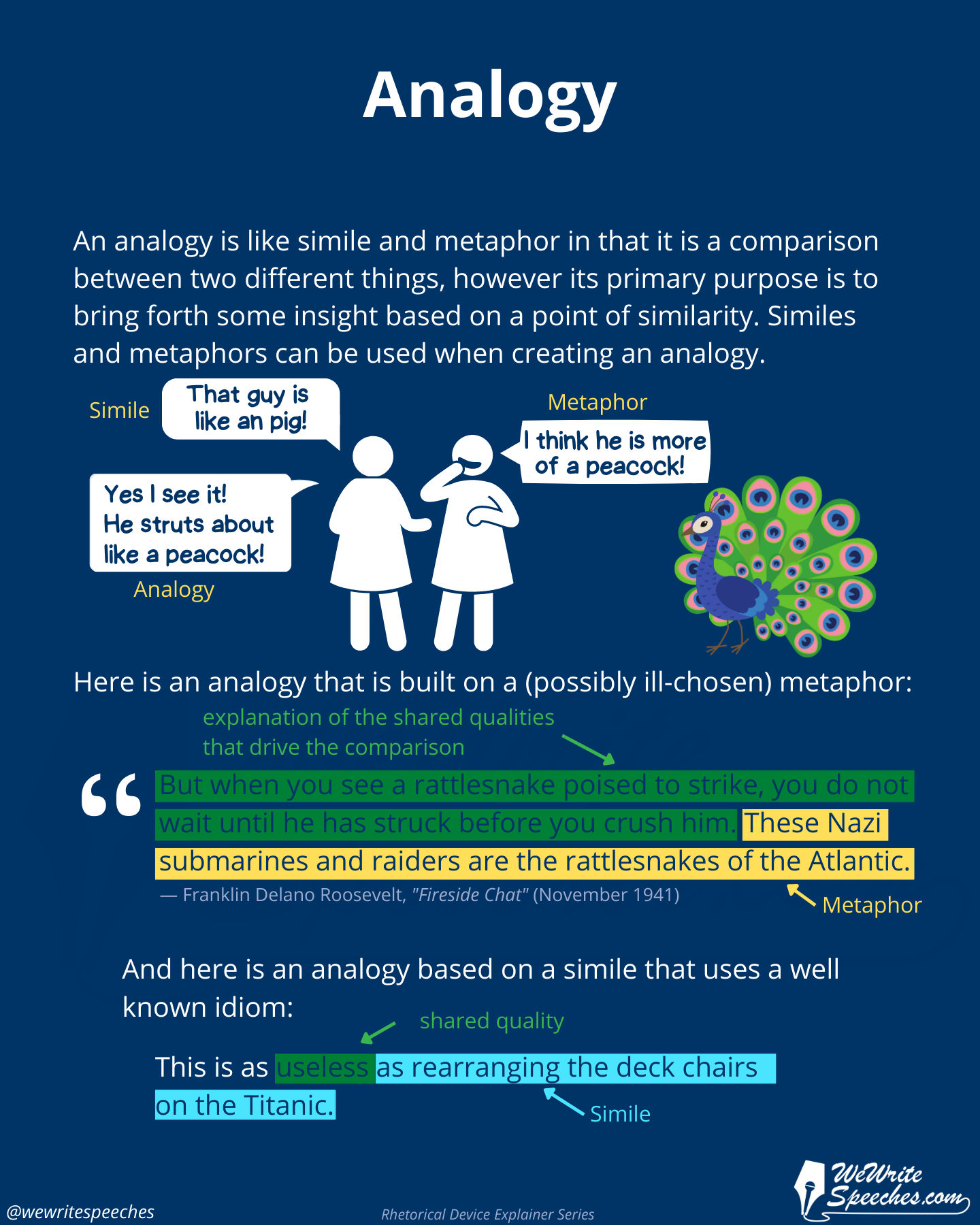Rhetorical Device: Analogy
Analogy is a powerful rhetorical device used in public speaking to make a comparison between two seemingly unrelated concepts. It allows the speaker to explain a complex or abstract idea in a way that is easier to understand by drawing a parallel to something more familiar. An analogy is like simile and metaphor in that it is a comparison between two different things, however its primary purpose is to bring forth some insight based on a point of similarity. In fact, analogies are often built using either a simile or a metaphor. Here are example of each, from John Oliver, speaking about the same controversial politician:
Donald Trump can seem appealingThis is the explanation part of the analogy. until you take a closer look, much like a lunch buffet at a strip club -- or the NFL.Learn more. John Oliver
Donald J. Trump It may have seemed harmless a year ago but now that it's become frighteningly bigger it's no longer wise to ignore it. This is the explanation part of the analogy. John Oliver
Another pattern that is used for creating analogies, goes as follows:
a is to b as x is to y.
This is such a well known formula that it has its own shorthand in teaching and academic circles. It is often rendered using a colon (:) to stand in for words, as in this example:
Dogs : wolves :: cats : lions .

This form of analogy doesn't explicitly explain the similarity but trusts the audience to understand how the two pairs being compared are similar. Here is a similar structure being deployed by Stephen Colbert to ridicule the claim by the organizer of Gun Appreciation Day that the event honored the legacy of Martin Luther King:
Yes, Dr. King is pro-gun just as surely as Jesus would be pro-nails.Stephen Colbert
Here is another analogy based on a comparison of pairs, this time from Irish rock band U2. The meaning may be implicit, but it is certainly clear.
And a woman needs a man
Like a fish needs a bicycle U2 "Tryin' To Throw Your Arms Around The World" lyrics © Polygram Int. Music Publishing B.v.
Here is another form of analogy, this time using a hypothetical situation to illustrate the choice the world is facing with regard to climate change. This is an extract from a blog (and Facebook) post by Arnold Schwarzenegger where he outlines a binary choice, uses hypophora to make explicit which one is the better option (in case it wasn't very obvious), and then completes the analogy by comparing the hypothetical choice to our current situation.
I have a final question, and it will take some imagination.
There are two doors. Behind Door Number One is a completely sealed room, with a regular, gasoline-fueled car. Behind Door Number Two is an identical, completely sealed room, with an electric car. Both engines are running full blast.
I want you to pick a door to open, and enter the room and shut the door behind you. You have to stay in the room you choose for one hour. You cannot turn off the engine. You do not get a gas mask.
I'm guessing you chose the Door Number Two, with the electric car, right? Door number one is a fatal choice - who would ever want to breathe those fumes? Learn more.This is the choice the world is making right now.
To use one of the four-letter words all of you commenters love, I don't give a damn if you believe in climate change. I couldn’t care less if you're concerned about temperatures rising or melting glaciers. It doesn't matter to me which of us is right about the science.
I just hope that you'll join me in opening Door Number Two, to a smarter, cleaner, healthier, more profitable energy future. Arnold Schwarzenegger, "I don’t give a **** if we agree about climate change" (7 December 2015) Blog & Facebook post
Analogy can be used to create a mental picture of a concept, to draw attention to a point, or to provide a deeper understanding of something abstract. An analogy can also be used to illustrate a point and to make an argument more convincing.
Using analogy in a speech is relatively easy. Start by identifying the concept you want to explain and then think of a comparison that will help to explain it. Make sure that the comparison is clear and easy to understand. If you are in any doubt that the audience might not understand it, make it explicit as Arnold did in the extract above. Finally, use vivid language to bring the analogy to life and engage your audience.
More examples
Life is like a box of chocolates — you never know what you’re gonna get. Forrest Gump
A woman is like a tea bag — you never know how strong she is until she gets into hot water. Eleanor Roosevelt
Being president is like running a cemetery: you've got a lot of people under you and nobody's listening. Bill Clinton
Withdrawal of U.S. troops will become like salted peanuts to the American public; the more U.S. troops come home, the more will be demanded. This could eventually result, in effect, in demands for unilateral withdrawal. Henry Kissenger, "Advice to President Nixon" (20 September 1969)
But when you see a rattlesnake poised to strike, you do not wait until he has struck before you crush him. These Nazi submarines and raiders are the rattlesnakes of the Atlantic. Franklin Delano Roosevelt, "Fireside Chat" (November 1941)
